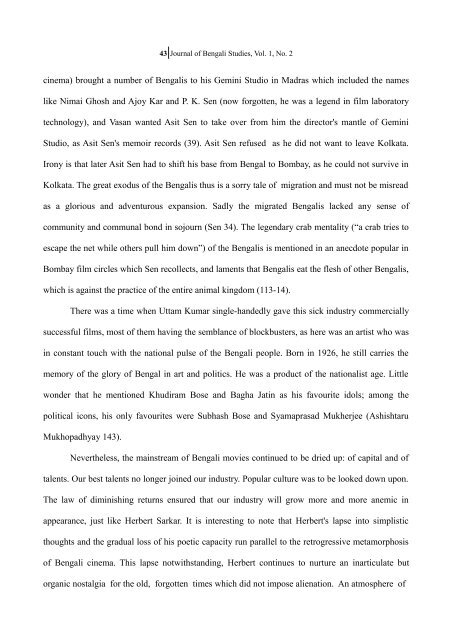A Selective Study in Post-Colonial Bengali Cinema - always yours
A Selective Study in Post-Colonial Bengali Cinema - always yours
A Selective Study in Post-Colonial Bengali Cinema - always yours
Create successful ePaper yourself
Turn your PDF publications into a flip-book with our unique Google optimized e-Paper software.
43|Journal of <strong>Bengali</strong> Studies, Vol. 1, No. 2<br />
c<strong>in</strong>ema) brought a number of <strong>Bengali</strong>s to his Gem<strong>in</strong>i Studio <strong>in</strong> Madras which <strong>in</strong>cluded the names<br />
like Nimai Ghosh and Ajoy Kar and P. K. Sen (now forgotten, he was a legend <strong>in</strong> film laboratory<br />
technology), and Vasan wanted Asit Sen to take over from him the director's mantle of Gem<strong>in</strong>i<br />
Studio, as Asit Sen's memoir records (39). Asit Sen refused as he did not want to leave Kolkata.<br />
Irony is that later Asit Sen had to shift his base from Bengal to Bombay, as he could not survive <strong>in</strong><br />
Kolkata. The great exodus of the <strong>Bengali</strong>s thus is a sorry tale of migration and must not be misread<br />
as a glorious and adventurous expansion. Sadly the migrated <strong>Bengali</strong>s lacked any sense of<br />
community and communal bond <strong>in</strong> sojourn (Sen 34). The legendary crab mentality (“a crab tries to<br />
escape the net while others pull him down”) of the <strong>Bengali</strong>s is mentioned <strong>in</strong> an anecdote popular <strong>in</strong><br />
Bombay film circles which Sen recollects, and laments that <strong>Bengali</strong>s eat the flesh of other <strong>Bengali</strong>s,<br />
which is aga<strong>in</strong>st the practice of the entire animal k<strong>in</strong>gdom (113-14).<br />
There was a time when Uttam Kumar s<strong>in</strong>gle-handedly gave this sick <strong>in</strong>dustry commercially<br />
successful films, most of them hav<strong>in</strong>g the semblance of blockbusters, as here was an artist who was<br />
<strong>in</strong> constant touch with the national pulse of the <strong>Bengali</strong> people. Born <strong>in</strong> 1926, he still carries the<br />
memory of the glory of Bengal <strong>in</strong> art and politics. He was a product of the nationalist age. Little<br />
wonder that he mentioned Khudiram Bose and Bagha Jat<strong>in</strong> as his favourite idols; among the<br />
political icons, his only favourites were Subhash Bose and Syamaprasad Mukherjee (Ashishtaru<br />
Mukhopadhyay 143).<br />
Nevertheless, the ma<strong>in</strong>stream of <strong>Bengali</strong> movies cont<strong>in</strong>ued to be dried up: of capital and of<br />
talents. Our best talents no longer jo<strong>in</strong>ed our <strong>in</strong>dustry. Popular culture was to be looked down upon.<br />
The law of dim<strong>in</strong>ish<strong>in</strong>g returns ensured that our <strong>in</strong>dustry will grow more and more anemic <strong>in</strong><br />
appearance, just like Herbert Sarkar. It is <strong>in</strong>terest<strong>in</strong>g to note that Herbert's lapse <strong>in</strong>to simplistic<br />
thoughts and the gradual loss of his poetic capacity run parallel to the retrogressive metamorphosis<br />
of <strong>Bengali</strong> c<strong>in</strong>ema. This lapse notwithstand<strong>in</strong>g, Herbert cont<strong>in</strong>ues to nurture an <strong>in</strong>articulate but<br />
organic nostalgia for the old, forgotten times which did not impose alienation. An atmosphere of

















